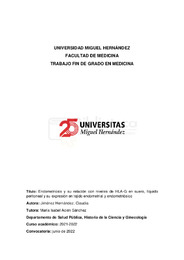Por favor, use este identificador para citar o enlazar este ítem:
https://hdl.handle.net/11000/28839Registro completo de metadatos
| Campo DC | Valor | Lengua/Idioma |
|---|---|---|
| dc.contributor.advisor | Acién Sánchez, María Isabel | - |
| dc.contributor.author | Jiménez Hernández, Claudia | - |
| dc.contributor.other | Departamentos de la UMH::Salud Pública, Historia de la Ciencia y Ginecología | es_ES |
| dc.date.accessioned | 2023-01-31T11:47:21Z | - |
| dc.date.available | 2023-01-31T11:47:21Z | - |
| dc.date.created | 2022-05-11 | - |
| dc.identifier.uri | https://hdl.handle.net/11000/28839 | - |
| dc.description.abstract | La endometriosis es una enfermedad ginecológica cuya patogénesis se encuentra en continua investigación. La hipótesis más aceptada en la actualidad sugiere la existencia de implantes peritoneales fuera de la cavidad uterina como resultado de la menstruación retrógrada y un sistema de inmunovigilancia intraperitoneal deprimido. Se sugiere que la implantación de los focos endometriósicos y progresión de la enfermedad es debido a una disminución de la actividad de las células natural killer, receptores del antígeno leucocitario humano G (HLA-G). El ligando HLA-G se ha identificado en células presentes en el tejido endometrial, suero y líquido peritoneal de pacientes con endometriosis y pacientes sanas, así como afectas de otras patologías ginecológicas como miomas, patología tubárica u ovárica. En la presente revisión sistemática se estudia la relación entre el grado y los tipos de endometriosis y la concentración o expresión de HLA-G en tejido endometrial eutópico, endometriósico, suero y líquido peritoneal, la variación durante las fases del ciclo menstrual y la relación con otras patologías ginecológicas. | es_ES |
| dc.description.abstract | Endometriosis is a gynecological disease whose pathogenesis is under continuous investigation. The most accepted hypothesis suggests the existence of peritoneal implants outside the uterine cavity because of retrograde menstruation and a depressed intraperitoneal immunosurveillance system. It is suggested that the implantation of endometriotic foci and the progression of the disease is due to a decrease in the activity of natural killer cells, receptors for human leukocyte G (HLA-G). The ligand HLA-G has been identified in cells located in the endometrial tissue, serum and peritoneal fluid of patients with endometriosis and healthy patients, as well as those affected by other gynecological pathologies such as fibroids, tubal or ovarian pathology. In this systematic review, we study the relationship between the degree and types of endometrioses and the concentration or expression of HLA-G in eutopic endometrial tissue, endometriotic tissue, serum and peritoneal fluid, the variation during the phases of the menstrual cycle and the relationship with other gynecological pathologies. | es_ES |
| dc.format | application/pdf | es_ES |
| dc.format.extent | 39 | es_ES |
| dc.language.iso | spa | es_ES |
| dc.publisher | Universidad Miguel Hernández de Elche | es_ES |
| dc.rights | info:eu-repo/semantics/openAccess | es_ES |
| dc.rights.uri | http://creativecommons.org/licenses/by-nc-nd/4.0/ | * |
| dc.subject | Endometriosis | es_ES |
| dc.subject | Antígenos | es_ES |
| dc.subject | HLA-G soluble | es_ES |
| dc.subject | Suero | es_ES |
| dc.subject | Líquido peritoneal | es_ES |
| dc.subject | Tejido endometrial eutópico | es_ES |
| dc.subject | Focos endometriales ectópicos | es_ES |
| dc.subject | Células natural killer (NK), | es_ES |
| dc.subject | Inmunosupresión | es_ES |
| dc.subject | Menstruación retrógada | es_ES |
| dc.subject | Ciclo menstrual | es_ES |
| dc.subject.other | CDU::6 - Ciencias aplicadas::61 - Medicina | es_ES |
| dc.title | Endometriosis y su relación con niveles de HLA-G en suero, líquido peritoneal y su expresión en tejido endometrial y endometriósico | es_ES |
| dc.type | info:eu-repo/semantics/bachelorThesis | es_ES |

Ver/Abrir:
JIMÉNEZ HERNÁNDEZ, CLAUDIA, TFG.pdf
2,11 MB
Adobe PDF
Compartir:
 La licencia se describe como: Atribución-NonComercial-NoDerivada 4.0 Internacional.
La licencia se describe como: Atribución-NonComercial-NoDerivada 4.0 Internacional.
.png)